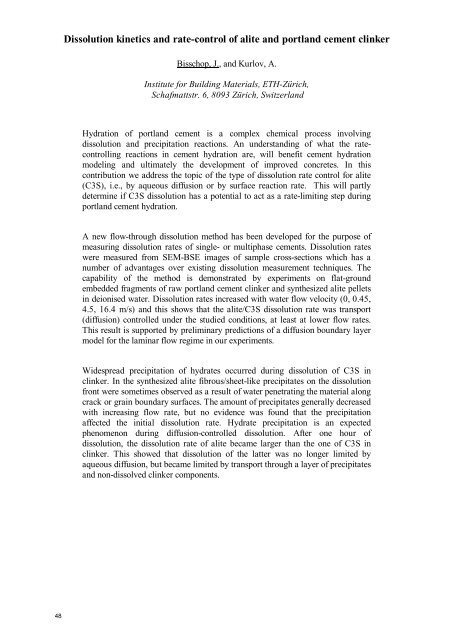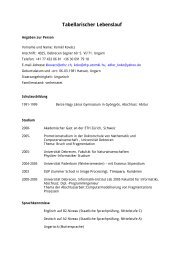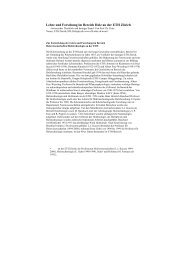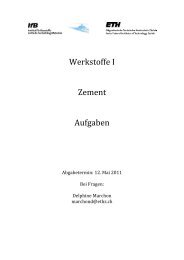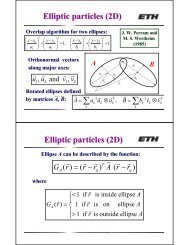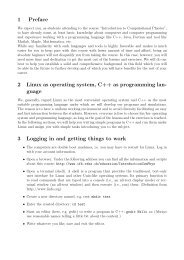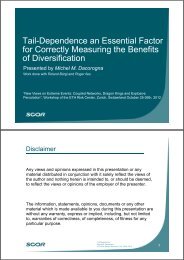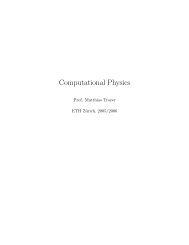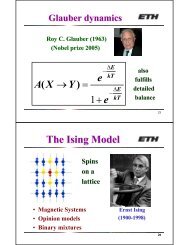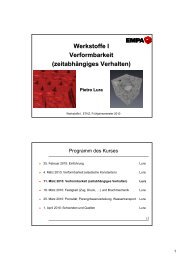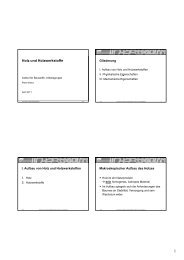Dissolution kinetics and rate-control of alite and portland cement clinkerBisschop, J., and Kurlov, A.<strong>Institute</strong> <strong>for</strong> <strong>Building</strong> <strong>Materials</strong>, <strong>ETH</strong>-Zürich,Schafmattstr. 6, 8093 Zürich, SwitzerlandHydration of portland cement is a complex chemical process involvingdissolution and precipitation reactions. An understanding of what the ratecontrollingreactions in cement hydration are, will benefit cement hydrationmodeling and ultimately the development of improved concretes. In thiscontribution we address the topic of the type of dissolution rate control <strong>for</strong> alite(C3S), i.e., by aqueous diffusion or by surface reaction rate. This will partlydetermine if C3S dissolution has a potential to act as a rate-limiting step duringportland cement hydration.A new flow-through dissolution method has been developed <strong>for</strong> the purpose ofmeasuring dissolution rates of single- or multiphase cements. Dissolution rateswere measured from SEM-BSE images of sample cross-sections which has anumber of advantages over existing dissolution measurement techniques. Thecapability of the method is demonstrated by experiments on flat-groundembedded fragments of raw portland cement clinker and synthesized alite pelletsin deionised water. Dissolution rates increased with water flow velocity (0, 0.45,4.5, 16.4 m/s) and this shows that the alite/C3S dissolution rate was transport(diffusion) controlled under the studied conditions, at least at lower flow rates.This result is supported by preliminary predictions of a diffusion boundary layermodel <strong>for</strong> the laminar flow regime in our experiments.Widespread precipitation of hydrates occurred during dissolution of C3S inclinker. In the synthesized alite fibrous/sheet-like precipitates on the dissolutionfront were sometimes observed as a result of water penetrating the material alongcrack or grain boundary surfaces. The amount of precipitates generally decreasedwith increasing flow rate, but no evidence was found that the precipitationaffected the initial dissolution rate. Hydrate precipitation is an expectedphenomenon during diffusion-controlled dissolution. After one hour ofdissolution, the dissolution rate of alite became larger than the one of C3S inclinker. This showed that dissolution of the latter was no longer limited byaqueous diffusion, but became limited by transport through a layer of precipitatesand non-dissolved clinker components.48
Autogenous shrinkage in oil well cementsA. Blanc1,2 , P. Faure 1 , S. Le Roy-Delage 2 , T. Fen-Chong 11 UR Navier, Champs sur Marne, France. 2 Schlumberger EPS, Clamart, France.INTRODUCTION: The work presented hererelates to cementing in an oilfield background andspecifically focuses on the hydration of the cementpaste and the autogenous de<strong>for</strong>mations that canoccur. During the cement hydration, theconsumption of water in the pores creates adepression that causes eventual shrinkage of thematerial, which is critical as the sealing role of thecement annulus may be lost, at greatenvironmental as well as production cost. Therange of temperature and pressure conditions towhich the cement paste is exposed is very large,going up to hundreds of degrees Celsius and barsdown hole. The access to water coming from therock <strong>for</strong>mations is also an important parameter inthat it can compensate water consumption.M<strong>ETH</strong>ODS: These effects have been included ina modelling work by Brice Lecampion <strong>for</strong>Schlumberger. He created an incremental model torelate the hydration of the cement toporomechanical stress and strain, depending onpressure and temperature as well as access towater. <strong>Here</strong>, we try to bring experimental results toback up these results, by investigating thehydration of early-age cement paste.We first use uniaxial creep tests to explore theevolution of mechanical properties after around 24hour of hydration. The samples are made with aclass G cement paste with a water to cement ratioof 0.45, and moulded as cylinders of 2 cmdiameter and 10 cm height. After 24 hours, theyare submitted to a constant vertical compressivestress and the de<strong>for</strong>mations over time are measured<strong>for</strong> 72 hours. We tried first a stress of 5.1 MPa,then went down to 1.7 Mpa.We also used NMR measurements to get a closerscale point of view on the setting phase. Thestudies were per<strong>for</strong>med on a 0.5 T imager (protonresonance at 20 MHz). This low magnetic fieldreduces the apparition of inhomogeneities,allowing to observe large samples (around 500g),which is well suited <strong>for</strong> this type of materials. Wemeasure both the overall signal variation and theT1 relaxation over time in a setting paste. In orderto have a better control on curing temperature andaccess to water, we also use a Minispec unit withtemperature control. The samples are muchsmaller, from 1 to 5 g, and we explored atemperature range from 5 to 60 degrees, with orwithout access to water <strong>for</strong> the cement paste.RESULTS: The creep tests results show a highdispersion, due to large variation of the elasticstrain. The long-time stress however is quitereproducible, especially with the lower value ofstress.Fig. 1: Creep results with two values of stressThe NMR measurement show a good correlationbetween the decrease of the total signal and thesimulated degree of hydrationFig. 2:Measured water consumption againstmodelled hydration degree during 14 daysDISCUSSION & CONCLUSIONS: We will nowapply these measurements methods to cementspastes with various curing temperatures and witheventual access to water. This includes creating awater circulation device that we plan to adapt tothe creep experiment.49


